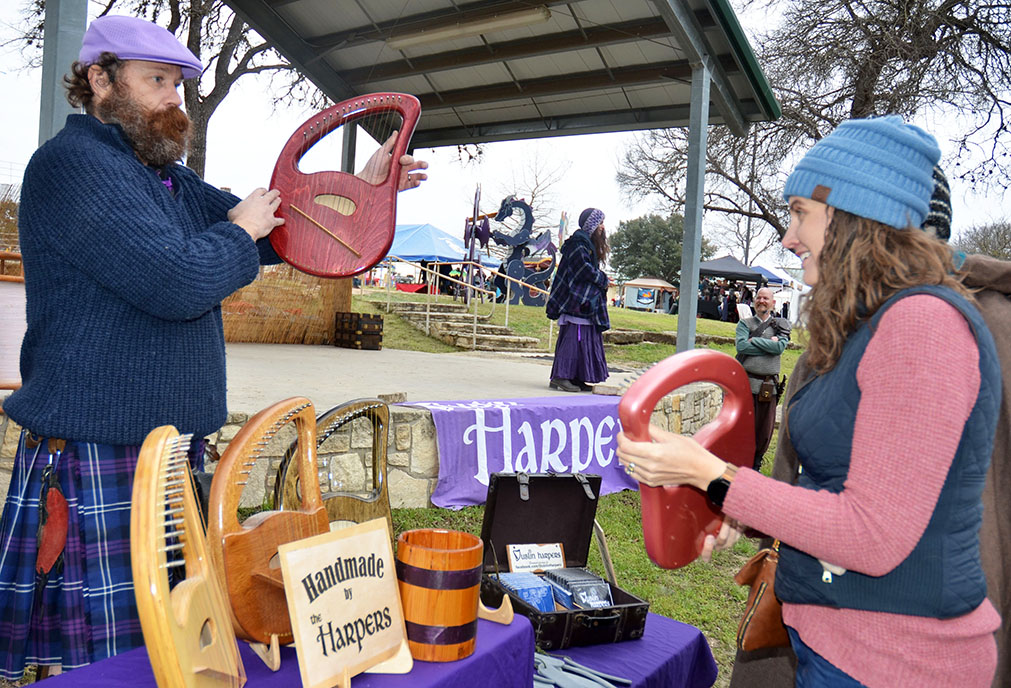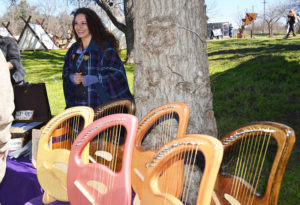
Benjamin of the Dublin Harpers demonstrates the Harp Lyre he designed and built for fans inspired by his family’s Renaissance performances. Photo by Phil Houseal
Jan 31, 2024–Audiences for the Dublin Harpers are so enamored with the lilting sound of the Celtic harp, they go away wanting to play it themselves. Unfortunately, the care and feeding of a full-size authentic harp is beyond the grasp of most casual players.
It’s a phenomenon Benjamin and Candyce Harper noticed over 11 years of performing with their four children at Renaissance Festivals across the country.
“The cost of even a basic Celtic harp starts well over $1200,” said Candyce, mom and main harpist. “And those are more harp than most beginners care to handle.”
Last year they decided to do something about it. So Benjamin, who trained at the Columbus College of Art and Design, began tinkering in his workshop, guided by Candyce, who studied Harp Performance at the Eastman School of Music. In a short time, they designed and built a brand new instrument–the Dublin Harpers Teardrop Harp Lyre.
As the name says, it’s a cross between a harp and a lyre.
The striking instrument is only 18” by 12” (fits in a carry-on!) so it can be cradled in playing position on the forearm and held close to the chest. It boasts 16 strings tuned to a C-Major Diatonic scale. It can be tuned into any key, and even reconfigured to play other than the major scales. An opening allows the harpist to strum and pluck using both hands, mimicking the feel of a traditional harp.
That similarity to a full-size harp is an important part of their design.
“Lyres don’t lend themselves to transitioning to the harp because the strings are going the wrong way,” Benjamin said. “So we reversed them. We also built these instruments so that the string spacing is the same as the harp, so your muscle memory is going to be the same.”
Each harp is made by hand, using birchwood sheets laminated into 30 layers for durability and acoustical properties. The base model is acoustic and starts at $180. Benjamin also figured out how to add a pickup and jack to allow it to be amplified for group playing.
As to finishes, the harps range from natural wood tones to high-gloss black to purple sparkle, with every shade in between. The most popular color is pink.
 “Hey,” said Candyce, “if you’re going to make a harp, why not make it sparkle?”
“Hey,” said Candyce, “if you’re going to make a harp, why not make it sparkle?”
Even though just introducing the new instrument at the Texas Renaissance Faire last November, it has been an immediate hit. Benjamin is hard-pressed to make them fast enough to keep in stock. But for the Dublin Harpers, the desire to “put harps into the world” goes beyond business calculations.
“We want to spread the harp around,” he said, noting the popularity of the harp in European culture. “We want to place a harp in every home.”
They noted how harps are used in music therapy, something they did at a recent celebration of life for a dear friend. They passed around their new harps for people to play, creating a gathering that was “calming and uplifting.”
“It really settled the room,” Candyce said. “It got everybody into the present moment. When you think of harp, you don’t think of anything sad. Harp music is very light and airy and happy. That’s what we really strive to do with our show and with the lyres.”
On the Renaissance circuit, the Dublin Harpers perform traditional, folk, Irish, Scottish, and Celtic music and dance. Off stage, Candyce gives harp lessons, and she has started a YouTube channel to demonstrate how to play popular songs on their new instrument.
“I always tell my students ‘Happy Harping.’ That’s our thing.”
A “thing” now easier for beginners to try with the Dublin Harpers Teardrop Harp Lyre.
Details:
The Dublin Harpers will perform for the final weekend of the Kerrville Renaissance Fest on Feb 3 and 4.
Information on their Harp Lyre can be found at purpleharp.com